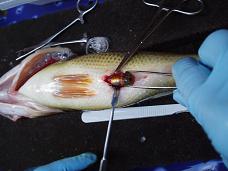|
Tagging Procedure and Techniques |
 |
|
There are various techniques that can be used to tag fish for biologging and biotelemetry applications. In regards to studies of this nature, our lab focuses on minimizing the impacts from handling, the tagging procedure, and the presence of the device on the behaviour/physiology of the animal. When a fish is being tagged, with an externally attached or surgically implanted device, it should not be held out of water regardless of how long the process takes. Air exposure is one of the major stressors for fish. In most cases, the |
|
negative physiological consequences resulting from air exposure far exceed those of the actual tagging procedure. Ideally, aerated water should be continuously flowing over the gills throughout the duration of the tagging process, but static water can work for some situations. The size and weight of the device used should carefully be considered, so that the device does not restrict or alter the normal activity/behaviour of the animal. The following information outlines various telemetry devices and procedure/techniques, in which they are attached, adapted from the unpublished chapter on attachment of devices (Cooke, Unpublished). |
|
|
